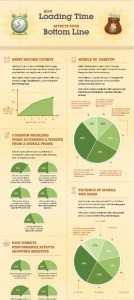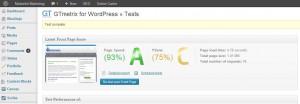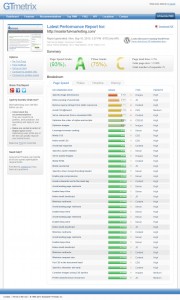 We are an impatient society. We want things immediately and get frustrated when we have to wait for anything. When it comes to finding things on the Internet, our patience is probably even less. If your website speed does not meet the patience criteria of the visitor, they will hit the back button, sending a signal to Google that your website is not a quality user experience. That behavior, over time, will likely affect your search engine ranking.
We are an impatient society. We want things immediately and get frustrated when we have to wait for anything. When it comes to finding things on the Internet, our patience is probably even less. If your website speed does not meet the patience criteria of the visitor, they will hit the back button, sending a signal to Google that your website is not a quality user experience. That behavior, over time, will likely affect your search engine ranking.
In addition, we build our websites in WordPress, a wonderful content management system that gives us oh so many options and puts us in control. But guess what? All this control and flexibility can affect how well our websites perform for our businesses.
Why Does Website Speed Matter?
There are two major reasons to care about how fast your website loads.
User Experience
KISSmetrics Loading Time Infographic
In this impatient world, how long do you wait for a page to load? And if it doesn’t load within your speed criteria, do you click the back button? I do!
The faster the page load time, the better the user experience. An improved user experience translates into higher conversions and more revenue.
People want and need a fast online user experience. According to KISSmetrics, most users will wait 6 – 10 seconds before they abandon the page. However, according to Google, browsers need to load in 200 ms or less and mobile sites need to load in less than 1 second.
Organic Rankings
Page Speed is an important ranking factor and is one of the many signals Google uses as part of its ranking algorithm for both desktop and mobile. Having a better-optimized page will help deliver better rankings and can give your site an advantage over your slower loading competitors.
How to test your website speed
Assessing the page load speed of your website is something that may sound difficult. You may wonder how you can know how fast your site is not only for your visitors but also in the eyes of the search engines.
Google provides a tool called PageSpeed Insights that measures you website’s page speed and provides detailed information on how you can improve your load time. You can access the tool either directly by entering the URL of the page or through Google Analytics in the content area under Site Speed / Speed Suggestions. Click the link under the “Page Speed Suggestions” column that indicates the number of optimization suggestions available for that page for a report similar to the following:
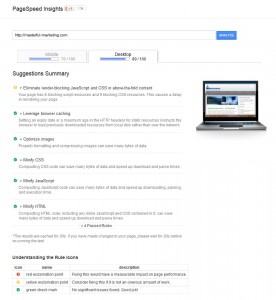
Google Pagespeed Insights – Desktop
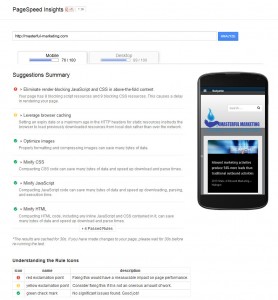
Google Pagespeed Insights – Mobile
GTmetrix also provides a page speed report and offers a nifty WordPress plugin so you can run an analysis from within your WordPress dashboard.
GTmetrix WordPress Dashboard
Simply click on the detailed report link for the full report:
GTmetrix Full Report
GTmetrix also provides a WordPress optimization guide.
The goal of both these tools is to evaluate your web page based on a set of rules and provide recommendations that you can use to improve the page load speed of your website.
Optimizing the Speed of your WordPress Website
Most of us are running WordPress to power our website and blog which means you are most likely running a theme and multiple plug-ins. This implies that there are at several CSS and Javascript files that need to be loaded. Where and how they load is mostly not in our power.
There are, however, things you can do that helps your website performance.
1. Use plugins sparingly
Use only those plugins you absolutely need. As much as I just love plugins, I chose to remove plugins that did not contribute to the user experience. The more you load, the slower your website.
2. Ensure your images are reduced in size
Many users don’t realize that the image you took on your smartphone is a high resolution 2 megabyte or more file. If used in its original format, loading that file or even its thumbnail can slow down your page speed. If you want a quality image, create a file that is no bigger than 9 by 12 inches at 72 ppi (pixels per inch) which is 864 by 648 pixels and link it to the thumbnail so that it loads in a lightbox. Use JPG images when possible as they have smaller file sizes than PNG. Unless you need the image to be transparent, use a JPG.
3. Install the WP Smush.it plugin
Even reducing the size of your images manually may still not be enough. The WP Smush.it plugin optimizes images as you upload them by automatically running them through Smush.it. Just install and activate the plugin.
4. Install a Caching Plugin
WordPress creates pages dynamically as they are requested by pulling the content from the database and applying the theme template. A cache plugin saves pages when they are retrieved so that future requests for the same page can be delivered faster. The two most popular plugins are WP Super Cache and W3 Total Cache. I personally like WP Super Cache for its simplicity.
4. Reduce your database size
Every time your write or edit a page or post, WordPress is keeping revisions. Each revision increases the size of your database, which slows down your website. I use the Revision Control plugin and set it to keep only 5 revisions.
Another factor that can cause database bloat are spam comments. To remove them from the database, simply click on the number of spam comments in the “Right Now” widget in your WordPress dashboard and then click on the “Empty Spam” button.
5. Use a Content Delivery Network (CDN) Service
A CDN delivers your site content to different networks so users can download your content from the closest server, which will increase load speed. There are several high performance CDN services and if you are running an eCommerce site, they are worth the fees. In addition, if you have a lot of traffic to your site, you may want to try CloudFlare, a free CDN that speeds up sites and provides protection against many security threats.
6. Transfer to a new hosting environment
Most of our websites run just fine in a shared hosting environment, but if do implement all the above and you still have a slow website, you may want to consider:
- Virtual Private Server – You still share the CPU with other virtual machines but have guaranteed dedicated access to the resources you purchase from the hosting company (memory, disk storage, transfer rate, etc.)
- Dedicated Server – You have full control of the physical server, and complete access to all its resources.
- Managed WordPress Hosting – Because of the popularity of WordPress, companies are emerging that specialize in creating an optimized WordPress environment with specialized support for WordPress, themes, and plugins.
WordPress puts control into the hands of marketers and small business owners, but with that power smart decisions need to be made when it comes to “feature rich” verses “website speed”. Balance the two for a quality user experience that keeps visitors coming back for more.
How have you increased your website page speed?
Article source: http://masterful-marketing.com/website-speed-important-for-inbound-marketing/

